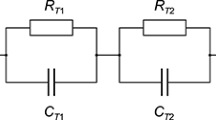Abstract
A method is proposed for numerical calculation of the temperature field of a generalized model of electronic equipment with high component density.
Similar content being viewed by others
Abbreviations
- x,y,z,x′,y′:
-
spatial coordinates, m
- τ:
-
time, sec
- Lx, Lv, Lz :
-
dimensions of heated zone, m
- λx, λy, λz :
-
effective thermal-conductivity coefficients of heated zone, W/m·deg
- λ2 :
-
thermal conductivity of chassis, W/m·deg
- a z :
-
thermal diffusivity of heated zone along z axis, m2/sec
- c1 :
-
effective specific heat of heated zone, J/kg·deg
- ρ1 :
-
effective density of heated zone, kg/m3
- c3, ρ3, c2, ρ2 :
-
thermophysical characteristics of cooling agent and chassis, J/kg·deg·kg/m3
- qv(x, τ), q(x′, y′):
-
volume heat-source distribution, W/m3
- qs (x):
-
surface heat-source distribution, W/m2
- p:
-
number of cooling agent channels
- Fo:
-
Fourier number
- Bi:
-
Biot number
- Ui :
-
coolant velocity in i-th channel, m/sec
- T1(x, τ), T2(x, τ), T3(x, τ):
-
temperature distribution of heated zone, chassis, and coolant, °K
- T30, T10(x), T20(x):
-
initial temperatures, °K
- T3in :
-
coolant temperature at input to channel, °K
- TT(x):
-
effective temperature distribution of heat loss elements, °K
- TC :
-
temperature of external medium, °K
- θ:
-
dimensionless heated zone temperature
- αv(x):
-
local volume heat exchange coefficient, W/m3·deg
- α12(x), α1C(x), α1T(x):
-
heat liberation coefficients
- W/m2·sec; β21(x′, y′), β2c(x′, y′), β2T(x′, y′):
-
volume heat-exchange coefficients of chassis with heated zone, medium, and cooling elements, W/m3·deg
Literature cited
I. Grekova, “Methodological peculiarities of applied mathematics in the present state of development,” Vopr. Filosof., No. 6, 104–115 (1976).
G. N. Dul'nev and N. N. Tarnovskii, Thermal Regimes of Electronic Equipment [in Russian], Energiya, Moscow (1971).
G. N. Dul'nev and B. V. Pol'shchikov, “Generalized thermal model of electronic equipment with high component density,” Izv. Vyssh. Uchebn. Zaved., Priborostr., No. 10, 121–125 (1976).
A. A. Samarskii, Theory of Difference Systems [in Russian], Nauka, Moscow (1977).
A. V. Lykov, Handbook of Heat-Mass Exchange [in Russian], Energiya, Moscow (1978).
Yu. G. Volodin and V. V. Gasanova, “Computer method for calculating the thermal regime of communications equipment,” Communications Technology [in Russian], Moscow (1977), pp. 62–69.
Author information
Authors and Affiliations
Additional information
Translated from Inzhenerno-Fizicheskii Zhurnal, Vol. 40, No. 5, pp. 876–882, May, 1981.
Rights and permissions
About this article
Cite this article
But'ko, E.F., Dul'nev, G.N. & Parfenov, V.G. Numerical calculation of a generalized thermal model of radio-electronic apparatus. Journal of Engineering Physics 40, 542–547 (1981). https://doi.org/10.1007/BF00822122
Received:
Issue Date:
DOI: https://doi.org/10.1007/BF00822122




